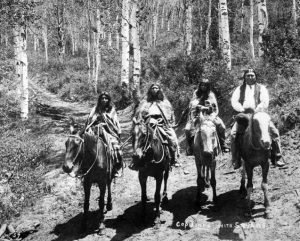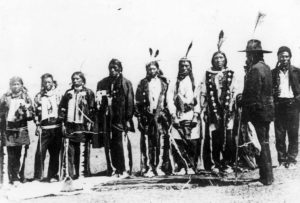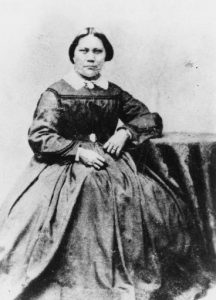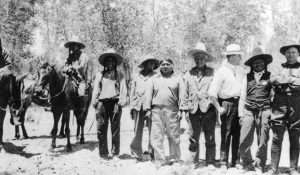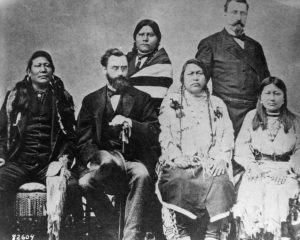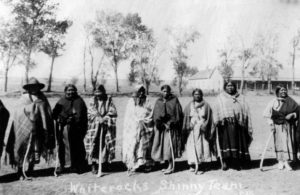Here we present a small gallery of Ute photographs found in the collection of the Utah State Historical Society. Although we do not use Google Picasa, we gathered as much contextual information as we could find to identify individuals in the photos. If you, dear reader, can help us identify more of the individuals in these photos, please contact us at [email protected].
- Captain Jinks, a Ute, with women in Atchee, Colorado. The identities of the women are not known.
- A group of White River Utes taken prisoner at Fort Meade, South Dakota, c. 1906. From left to right, Ben Tabbysheetz, unidentified, Ta-tw-wee Chegup, Mo-cha, Quien, J. Scott Apputnora, Quip, and Tse-uts. Faced with the unwanted opening of the Uintah Reservation to white settlers, a group of Ute Indians sought refuge in South Dakota among the Sioux. While in flight, the Indians were apprehended by the U.S. Army in southeast Montana and held as prisoners near Fort Meade, South Dakota. Although the federal government initially agreed to have the Utes remain in South Dakota, further conflict with the United States ultimately convinced the Indians to return to their reservation in Utah, which they did in 1908. For more, see David D. Laudenschlager, “The Utes in South Dakota, 1906–1908,” South Dakota History 9 (Summer 1979): 233–47.
- Sally Kanosh, recently married to the Pahvant chief Kanosh, ca. 1877. For nearly three decades, Sally was an adopted member of Brigham Young’s household, purchased from an Indian named Batiste in 1847. “At first [Sally] slept outside and preferred the meat she gathered from the gutters instead of good fried beef,” Young had exclaimed, but soon she came to adopt the Mormons’ customs and religion. She died in December of 1878. See John G. Turner, Brigham Young: Pioneer Prophet (Cambridge, MA.: Belknap Press of Harvard University Press, 2012), 215–16.
- Ute Indians standing with Charles Rendell Mabey, future governor of Utah, 1915. The only identifiable figures in this photograph are Washington Dutchie (fourth from left), Joe Bishop (fifth from left), Anson (sixth from left), Posey (second from right), and Mabey (far right). Posey, a Paiute who married into the Ute band, later became namesake of the 1923 conflict known as the Posey War.
- A group of Ute Indians posing with federal officials for a photograph in Washington, D.C., 1880. Front row, from left to right: Ignacio, chief of the Weeminuche band of the Ute tribe; Carl Shurz, U.S. Secretary of the Interior; Ouray, chief of the Uncompahgre band of the Ute tribe; and Chipeta, Ouray’s wife. Back row: Woretsiz, a Ute Indian, and Charles Adams, a U.S. Army officer and Indian agent. Ouray died later that year after negotiating a treaty that established a reservation for his people in Utah. Original credit: U.S. Signal Corps.
- Ute women on the Whiterocks Shinny Team. The game shinny involved using three-foot long sticks to strike a ball made of rawhide over the opponents’ goal line. The town of Whiterocks is in Uintah County, Utah.

